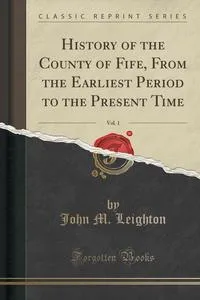History of the County of Fife, From the Earliest Period to the Present Time, Vol. 1 (Classic Reprint)
Автор: John M. Leighton
Переплёт: Мягкая обложка
📒 Excerpt from History of the County of Fife, From the Earliest Period to the Present Time, Vol. 1
Picts united. - Introduction of Christianity. - Culdees and their establishments in Fife.
The history of the Picts extends from 446, the period at which the Romans left Britain, till 843, when their government was overthrown by the Scots. The lineage of this peo ple has been the subject of much dispute among those who have written on the early history of Scotland, and long and very angry dissertations have been the result of the discussion. With one class of writers they are held to be a Celtic people, - in fact the descendants of the Caledonians, who at the first appearance of the Romans, Opposed their army under Agricola, at the foot of the Grampian mountains. Another class affirm them to have been a Gothic people, who had invaded Caledonia, and if they had not superseded, had overcome and reduced to slavery those tribes who had so success fully, and for so long a period, resisted Roman valour and discipline. Whatever Opinion we may have formed on the subject, it is not our intention here to renew the dispute; it is rather our object to narrate such of their proceedings as relate to our proper subject, and to give such notices of them as in that View may be considered necessary. It certainly does seem to be unquestionable that they were a Celtic people, the descendants of a portion of the Caledonian tribes; and that therefore their man ners, habits, and customs were the same with those of the tribes from which they were descended, except in so far as they may have been civilized and improved by their inter course with the Romans, and with the Romanized Britons south of the Forth and Clyde.
About the Publisher
Forgotten Books publishes hundreds of thousands of rare and classic books. Find more at www.forgottenbooks.com
This book is a reproduction of an important historical work. Forgotten Books uses state-of-the-art technology to digitally reconstruct the work, preserving the original format whilst repairing imperfections present in the aged copy. In rare cases, an imperfection in the original, such as a blemish or missing page, may be replicated in our edition. We do, however, repair the vast majority of imperfections successfully; any imperfections that remain are intentionally left to preserve the state of such historical works.
Picts united. - Introduction of Christianity. - Culdees and their establishments in Fife.
The history of the Picts extends from 446, the period at which the Romans left Britain, till 843, when their government was overthrown by the Scots. The lineage of this peo ple has been the subject of much dispute among those who have written on the early history of Scotland, and long and very angry dissertations have been the result of the discussion. With one class of writers they are held to be a Celtic people, - in fact the descendants of the Caledonians, who at the first appearance of the Romans, Opposed their army under Agricola, at the foot of the Grampian mountains. Another class affirm them to have been a Gothic people, who had invaded Caledonia, and if they had not superseded, had overcome and reduced to slavery those tribes who had so success fully, and for so long a period, resisted Roman valour and discipline. Whatever Opinion we may have formed on the subject, it is not our intention here to renew the dispute; it is rather our object to narrate such of their proceedings as relate to our proper subject, and to give such notices of them as in that View may be considered necessary. It certainly does seem to be unquestionable that they were a Celtic people, the descendants of a portion of the Caledonian tribes; and that therefore their man ners, habits, and customs were the same with those of the tribes from which they were descended, except in so far as they may have been civilized and improved by their inter course with the Romans, and with the Romanized Britons south of the Forth and Clyde.
About the Publisher
Forgotten Books publishes hundreds of thousands of rare and classic books. Find more at www.forgottenbooks.com
This book is a reproduction of an important historical work. Forgotten Books uses state-of-the-art technology to digitally reconstruct the work, preserving the original format whilst repairing imperfections present in the aged copy. In rare cases, an imperfection in the original, such as a blemish or missing page, may be replicated in our edition. We do, however, repair the vast majority of imperfections successfully; any imperfections that remain are intentionally left to preserve the state of such historical works.
Мнения
